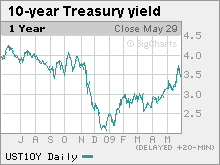Bonds sink as stocks surge
Government debt prices plummet with Wall Street in a triple-digit rally. The 30-year bond falls more than 3 points as fear trade wanes.
NEW YORK (CNNMoney.com) -- Government debt prices sank Monday as Wall Street rallied, with the Dow Jones industrial average adding as much as 221 points after General Motors filed for bankruptcy.
The 30-year bond lost more than 3 points and the benchmark 10-year note was down almost 2 points. Bond prices and yields move in opposite directions.
The 10-year benchmark yield, closely watched because it is correlated with home mortgage rates, touched 3.74% before retreating again to 3.7%. The benchmark yield hovered above 3.7% at various points last week. That's close to levels last seen November 13, when the yield ended at 3.84%.
Treasurys are considered one of the safest places to keep funds and are in demand in times of uncertainty. When the economy is on the upswing, however, investors are lured out of the safety of Uncle Sam's debt and into other, higher yielding and higher risk assets.
"The marketplace doesn't feel healthy, but it feels better than it did back in December, so you are taking out some of that fear premium," said Kenneth Naehu, managing director and head of fixed income at Bel Air Investment Advisors.
U.S. stocks followed a global equity rally, supported by a handful of better-than-expected economic reports. The Institute for Supply Management showed the pace of deterioration in the manufacturing sector was slower than expected in May. Construction spending unexpectedly rose 0.8% in April, marking its biggest increase in eight months, according to a report from the Commerce Department.
The global boost in sentiment comes despite significant turmoil in the U.S. automotive industry. General Motors (GM, Fortune 500) -- an automotive dynasty and once a symbol of America's manufacturing prowess -- filed a petition for Chapter 11 bankruptcy protection early Monday.
The filing had been anticipated for some time. But it also put the government on the hook for another $30 billion to support GM through the restructuring process. That comes on top of the initial $19.4 billion that GM got from Uncle Sam.
Constant supply of new debt issuance also added weight to Treasury prices. To fund stimulus efforts, the Treasury has been forced to bring record amounts of debt to market, and the supply has pushed prices lower and sent yields soaring. "Who is going to buy all that debt is a serious question," said Naehu.
In an effort to counteract rising yields, Treasury instituted a $300 billion debt buyback program but the program has been seen as too small to make a dent in the massive Treasury market. If the government steps up its commitment to the program - called quantitative easing - then Naehu suspects the government would pump up its commitment to the 10-year part of the curve.
"The 10-year is more closely associated with mortgages," said Naehu. If the government were to consider revamping the quantitative easing program, "they might not buy the 30-year, they might be buying more in the 10-year space."
Bond prices: The benchmark 10-year note sank nearly 2 to 95 6/32 and its yield rose to 3.71%, after edging as high as 3.74%. Bond prices and yields move in opposite direction.
The 30-year bond fell 3 15/32 to 95 2/32 and its yield shot up to 4.56%.
The 2-year note edged down 3/32 to 99 26/32 and its yield ticked up to 0.97%. The yield on the 3-month fell to 0.12% from 0.14%.
Lending rates: One key bank-to-bank lending edged down to another record low. The 3-month Libor fell to 0.65% Monday from 0.66%, according to Bloomberg.com. The overnight Libor rate also ticked down, hitting 0.26% from 0.27% Friday.
Libor, the London Interbank Offered Rate, is a daily average of rates that 16 different banks charge each other to lend money in London. The closely watched benchmark is used to calculate adjustable-rate mortgages. More than $350 trillion in assets are tied to Libor. ![]()


